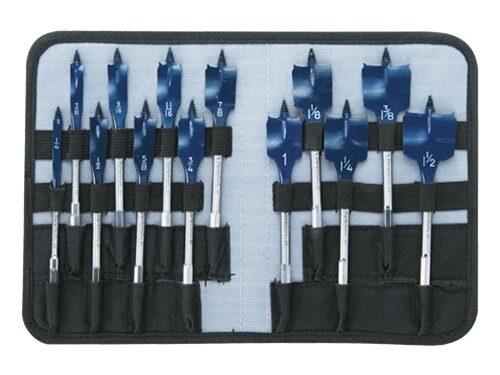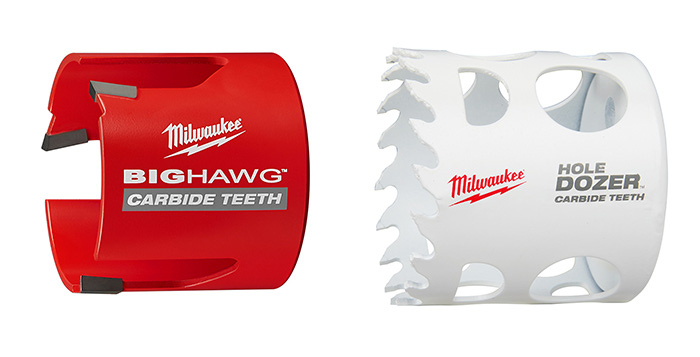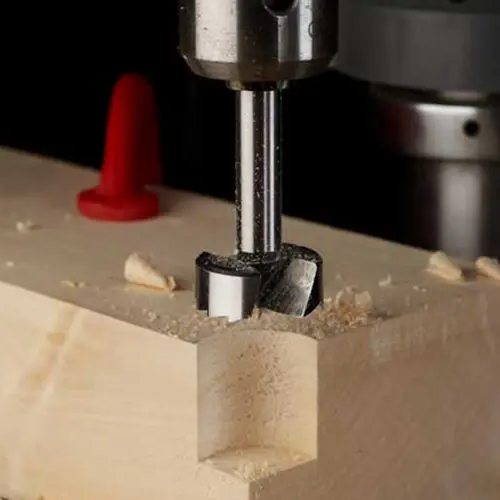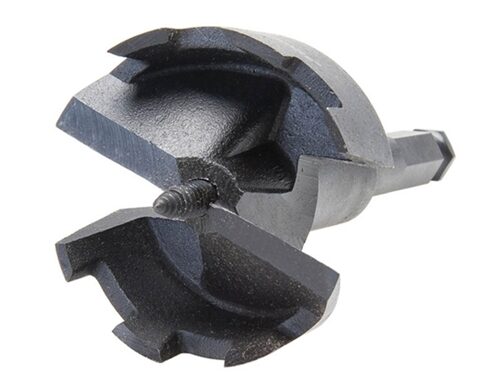When it comes to drilling holes in wood, there are a ton of tool and bit options out there to choose from. Hole saws, spade bits, auger bits, self-feed, and forstner bits are some of the most common choices for drilling into wood–but our most frequently asked question is how do you know which one to use?! Depending on the depth, quality, and quantity of holes that are needed, choosing the right bit does make a world of a difference, so here are some tips to help you drill the perfect hole needed for your project.

Spade Bits
Spade bits are wood boring drill bits that are flat with a sharp spear in the center and a spur on either side that quickly scoops material out of a bore hole. One benefit of spade bits is they are typically cheaper than other wood-boring bits, which is great if you’re drilling a lot of different sized holes.
Spade bits also bore holes quickly, making them a good option for drilling multiple holes at a time. They come wide range of different sizes, and being relatively inexpensive, that makes them a great versatile option for professionals and DIY’ers. We find that these bits work best with holes up to 1” in size, however, because once you go any larger you may start to lose control over the bit.
Another benefit to spade bits is that you can easily modify them by sharpening/filing them down with a file or bench grinder. This is helpful if you need to drill a hole that is slightly smaller than the bit you have or if you want to drill a tapered hole. Once the spurs wear down too much to cut through material, Spade bits can also be used for non-drilling applications, such as repurposing them as paint mixers to give them a second life. Just attach them to a power drill to make a quick and powerful paint mixer instead of mixing everything by hand!
While spade bits are super versatile, affordable, and relatively easy to use, there are a few disadvantages to them. Firstly, they can cause splintering when drilling all the way through a piece of wood, especially when drilling into hard wood. As the bit gets duller, the holes can get rougher, but you can easily re-sharpen them to get a nice clean cut again. Spade bits work best in a power drill instead of a hand drill because they require a little more force and precision to create a good hole. For the best results, you should place the tip on your piece and start off drilling at a low speed to get the drill secured into the wood and then increase the speed as you continue drilling to make sure it goes in straight. If you are in the market for Spade Bits, Bosch makes some of our favorites that make a great addition to any tool kit!
Auger Bits

Auger bits are one of the most common bits used for drilling holes into wood. The sharp point at the tip helps for precise drilling that creates a smoother hole than you typically would get with a spade bit. Auger bits can also drill deeper than most other bits, typically up to 31” deep and 3/8″-1″ wide, which makes them great for furniture applications, construction, and household woodworking. The spiral shape clears waste from the bore hole, so you don’t have to withdraw the bit half-way through the bore. They also require less force to operate because the spiral shape and guide screw at the tip pulls the bit into the wood. Drilling holes between floors for plumbing/electrical work and boring deep holes are some of the best uses for auger bits. Bosch also has a great selection of auger bits to choose from and are some of the most durable options out there. If you will be drilling in both metal and wood, twist drill bits may be a good option for you as well, though there is a difference in the tip of the bit as well as in diameter ranges.
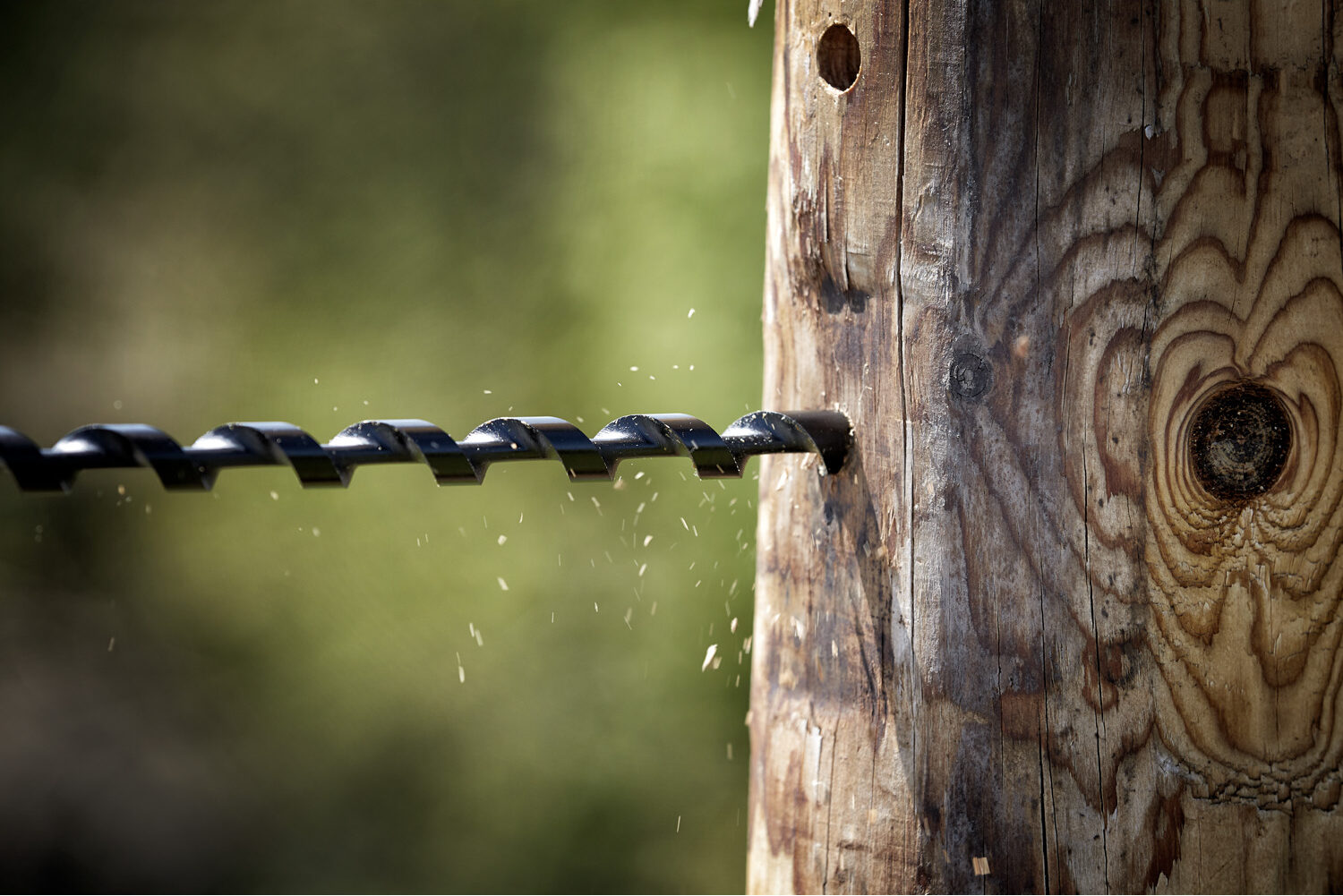
While Auger bits create cleaner holes than spade bits, they are slightly slower, so if you are drilling multiple holes, it will take a little bit longer. Additionally, they are only intended for wood use and can easily be damaged if used on the wrong material. Sometimes auger bits are known to break if they hit a knot in the wood because the guide screws are pretty fragile. So you need to be careful when working with one of these, however, these bits will create very uniform and clean cuts when used properly.
Hole Saws
Hole saws are a reliable option to cut larger holes in all types of wood including hardwoods, plywood, laminate, non-ferrous metals, plastic, and tiles. These are durable enough to cut perfect holes from 1″ all they way up to 6″ in diameter. Milwaukee makes some great hole saws in a ton of different sizes so you can cut the perfect hole for any application. For added durability, carbide hole saws are super tough and often last a lot longer than other other types of hole saws. They are more than capable of cutting through hard and soft woods.

Milwaukee hole saws even have 2 different kinds of carbide teeth options: their BIG HAWG Hole Saws and HOLE DOZER Hole Saws. The HOLE DOZER Carbide Teeth Hole Saws can cut through stainless steel, fastener embedded wood, cement board, fiberglass, plaster, cast iron, and more with ease. They have deep gullets to clear material faster when cutting and easy plug removal between cuts. The BIG HAWG Hole Saws with Carbide Teeth can cut through nail embedded wood, screws, plaster, shingles, cement board, and more. The carbide teeth on these are 10x larger than the HOLE DOZERs and can cut through material 5x faster.
Forstner Bits
Forstner bits are similar to standard twist drill bits, but are optimized for cutting wood specifically. These bits create super clean and precise cuts because they’re designed to produce a minimum amount of tear-out when exiting the material. These are great for drilling through-holes and flat-bottomed holes for hardware installation where your cutting depth needs to be precise. Forstner bits are typically used for 1/2″ to 2″ holes and will deliver the cleanest cut possible. They use the outside rim of the bit to guide it into the material so they can cut angled holes, partially overlapped holes, and holes at the edge of your material with a lot more stability than other bits.
Self-Feed Bits
Self-feed bits are essentially a hybrid of a hole saw and a spade bit. These bits have outer teeth that cut a wider circumference like a hole saw, with a radial blade in the center to drill out the core like a spade bit. These typically run from 1” to 4-5/8” in diameter for drilling larger holes. They provide a great balance of speed, accuracy, and clean hole cutting. Similar to spade bits, the radial blade in the center of self-feed bits can typically be sharpened to keep them going strong for longer.
One downside to self-feed bits is that they require a lot of torque, so you’ll need a higher-powered drill to use them. They are mainly intended to quickly drill through wood for holes that don’t need to be perfectly neat. For example, drilling a hole under cabinetry for lighting or pipe installation because the hole will not be seen. Self-feed bits are a little more expensive than the other bit options, but they are super long lasting because of how heavy-duty they are.
Which Do You Need?
So, let’s summarize: If you are going for speed over aesthetics, you should probably opt for a spade bit, or a self-feed bit if you need larger holes. If speed isn’t an issue and you want something that’s easy-to-use and will create nice clean cuts, an auger bit or forstner bit would work great. Self-feed bits are the more heavy duty option if you’re drilling a lot of holes or really large holes, and hole saws are a pretty universal option for cutting a lot of different materials and various sized holes.

Ohio Power Tool has a ton of bit and drill options for wood drilling from brands like Bosch, Milwaukee, Champion, DeWalt, Diablo, Spyder, and more! If you have any questions about the different wood boring tools and accessories we have in stock, give us a call at 800-242-4424, email us at sales@ohiopowertool.com, or leave a comment below for assistance. To be the first to know about new products and deals, subscribe to our e-newsletter and follow us on social media!


